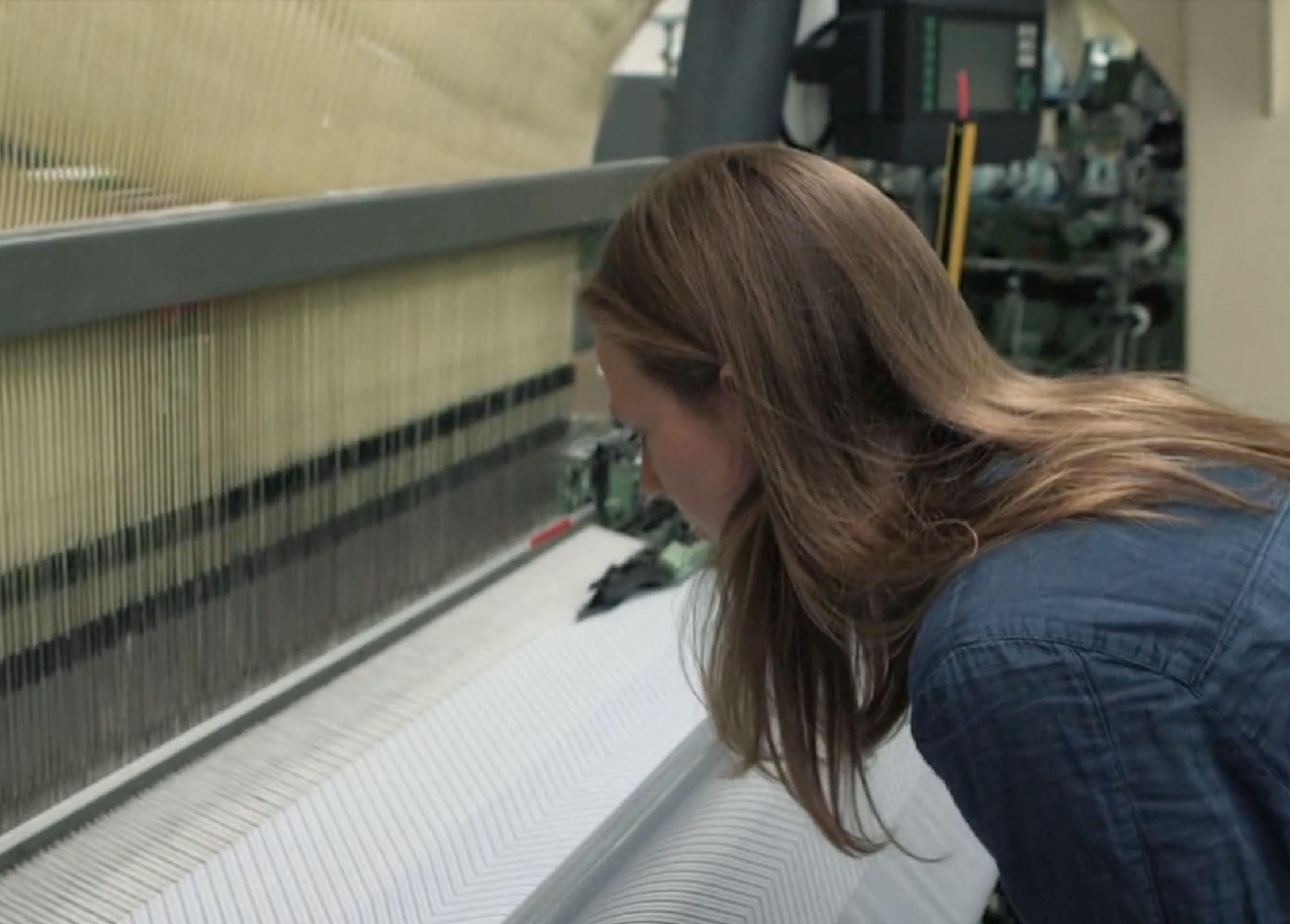Aliki van der Kruijs previously attempted to supervise production from a distance, but this didn’t suit her creative process. “Standing next to the product developer at the machine in the TextielLab allows you to respond immediately. That is the moment when you make the most wonderful discoveries.”
Designer Aliki van der Kruijs is inspired by the colours, textures and shapes of nature. In her woven fabrics, she captures the sky, the surface of the sea, the course of a river, a marshland landscape and the rain. Ten years ago, however, before she laid eyes on TextielLab’s weaving machine, she was captivated by the printer that was there at the time. Back then, she was working on her graduation project Made by Rain at the Sandberg Institute, in which she investigated the wearability of weather. After countless experiments by hand in her studio, the industrial textile printer caught her eye during an exhibition visit.
Film roll
Product developer Frans Verbunt was standing next to Van der Kruijs. Van der Kruijs’ questions about what the machine can do immediately inspired him: “he was very open to my ideas.” They were about interrupting the machine’s process for a natural intervention. Van der Kruijs wanted to take the printed fabric out of the machine before it’s set and then let raindrops form a pattern on the fabric. “You can compare it with an analogue roll of film, which requires exposure – in this case with water rather than light – and fixing. I couldn’t go to a textile company straight away for that experiment because they only produce massive batches. It was very rewarding to be able to try this out at the TextielLab. My concept transformed into a product: textile by the meter. I can endlessly conceptualise and sample in my studio, but in the lab it becomes something concrete. You can develop materials and techniques in a hands-on process.”

Made by Rain, photo: Pim Leenen
“Standing next to the product developer at the machine in the TextielLab allows you to respond immediately. That is the moment when you make the most wonderful discoveries.”
Indigo cords
After Made by Rain, Van der Kruijs frequently returned to the TextielLab. She learned how to weave jacquards for the Horizont project, which explores the area development project Room for the River with a tablecloth that depicts the changing course of the river IJssel. In the passement department, she immersed herself in the striking and gimping of cords in which the Japanese and Dutch traditions of indigo dyeing come together. She participates in the museum’s educational programme for primary schools, for which she shares her video tutorial on how to make a colour analysis with pupils. In the past year, she worked in the lab on a tapestry that incorporates the grain, colour and stratification of limestone from the Maastricht ENCI quarry. And alongside these projects, she consulted the lab team on the purchase of a TC2 machine, with which you can do jacquard weaving by hand.
Architecture
While working in the workshop, Van der Kruijs comes up with new findings that she archives for later. “When I used slightly different yarns for a pattern for the marl project, which I had already woven with linen and paper, it became something completely different. In the future, I would like to explore this potential of transforming an image by using a different material further.” She adds the discoveries made on the machines to her research archive. The elements that I have included over the past ten years are building blocks for the next step. She wants to develop textiles that react to spaces and soften them. Van der Kruijs shares: “I am more of a process person than a product maker anyway. Perhaps I see myself more as a director of the process than as a designer.”

Playing with parameters
Instead of considering the loom as a printer that uniformly translates her drawings into textiles, Van der Kruijs gives the machine a creative role by playing with the parameters. “I like to push techniques, to uncover potential where you couldn’t have envisioned it beforehand. You can’t plan that; you have to be physically present for it. I work very intuitively and in direct response to what’s happening. Because in the TextielLab, you’re right by the machine you can react immediately. Stop the machine, choose another yarn. I’m constantly going back and forth from desk to thread bank to loom. Lab days are high focus days, where you can work very swiftly and where all the ingredients are at hand.”
Exchange
The museum has asked her to develop a piece about the colour black for the new exhibition Kleurstof, which opens in the museum next spring. The prospect of doing this in the TextielLab sparked enthusiasm straight away. “I love working in the lab. It is extraordinary to see the results of the collaborations there. I also make progress with my work because of the many experts with abundant knowledge about textiles there. You play together in search of the right translation. During our last project, product developer Lotte van Dijk told me that the way I ask questions also teaches her a lot. I don’t know all the limitations of the system, so I’m not limited by them either. This creates a nice exchange between the product developer and designer. I really enjoy that.”